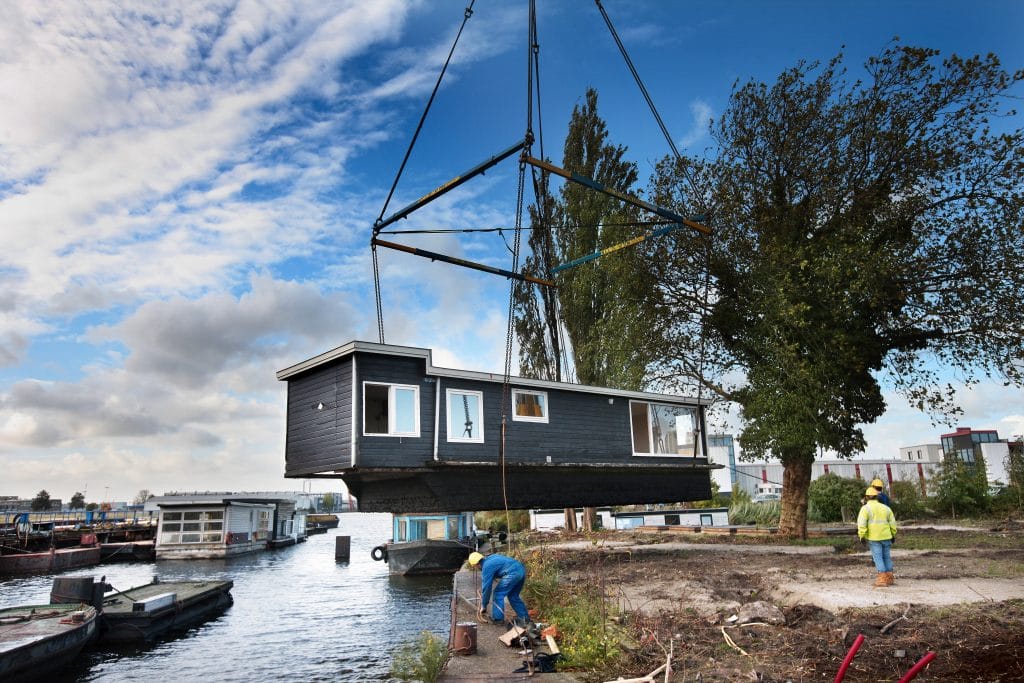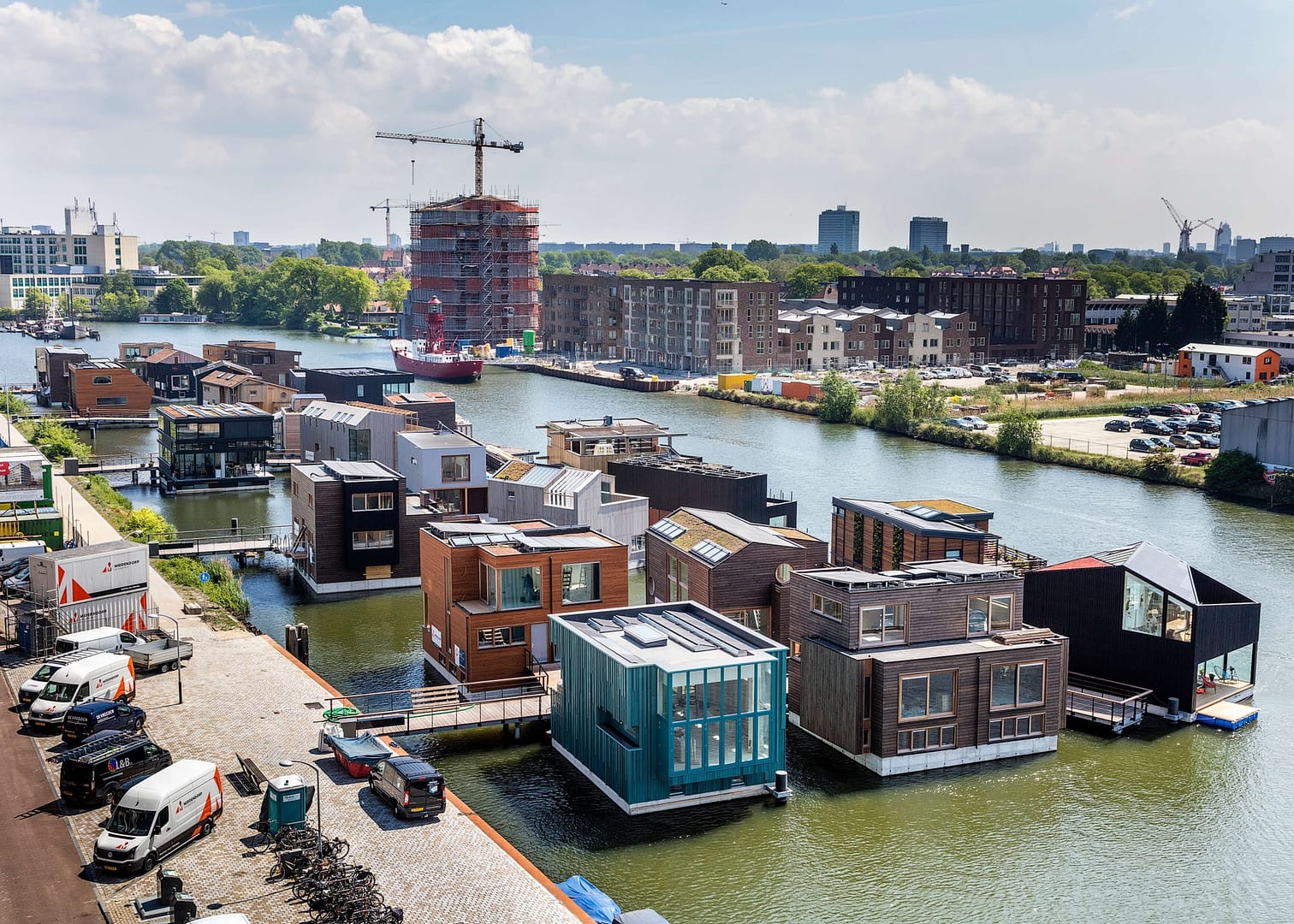When most people think of recycling, they think of tossing glass bottles and plastic containers into the right bin. But what if we could recycle not just the products we use, but the very land itself?
As it celebrates its fifth anniversary, the De Ceuvel cleantech playground has put the idea of land recycling into action. Once a polluted industrial shipyard in the north of Amsterdam, De Ceuvel is today a thriving hub of entrepreneurs and artists, featuring creative workspaces, a cultural venue, a sustainable café, and even a floating bed & breakfast.
De Ceuvel is at the heart of the regeneration of the 100-hectare Buiksloterham industrial estate. A polder born out of the dredging of the IJ river with contaminant-laden materials, Buiksloterham’s pollution problem worsened when heavy industry set up shop in the area.
Contaminated land in a prime location
In the latter half of the twentieth century, the petroleum industry and manufacturers abandoned this place for lower-wage countries, leaving local authorities with swathes of unused land in a prime location – but most of it contaminated with immobile contaminants such as heavy metals and asbestos. Where the Dutch had once reclaimed this land from the sea, this time they wanted to reclaim Buiksloterham from industry.
Huge chunks of disused industrial terrain around the world are left dormant due to the cost and time needed to recycle land, but Buiksloterham has gone from housing 252 people in 2013 onto a path to a thriving community of 6500 residents, 8000 workers, and 30,000 annual visitors. How has this happened?

An aerial photo of Buiksloterham, a former brownfield site transitioning to a circular neighborhood in Amsterdam.
The polder model
One of the secrets of this land recycling project, according to Metabolic founder Eva Gladek, lies in the Dutch cultural tradition of intensive planning and collaboration, essential to life in a country where 30% of the land lies below sea level. “It is the culture of the polder model, where people are used to tackling almost insurmountable challenges by bringing all the relevant stakeholders together into a room and discussing how it could work,” she says. “They like to fund research, analyse it, come up with strategies and visions: this is very Dutch, but not very common in most other countries.”
Amsterdam’s municipal development office Grond & Ontwikkeling, local water utility Waternet, and social housing corporation De Alliantie approached development at Buiksloterham via a mix of bottom-up development and a top-down master plan that enabled individual landowners to put in tenders to build what they wanted, guided by sustainability performance criteria. This allowed Buiksloterham to become a hotbed of small-scale experimentation with room for failure.

De Ceuvel was created by lifting old houseboats onto land and retrofitting them to become offices. Photo credit: Jean-Pierre Jans.
Plants that can clean the land of pollutants
In 2012, a team of organisations including Metabolic secured a ten-year lease at De Ceuvel, a plot of land blighted with mineral oils, polycyclic aromatic hydrocarbons, mercury, copper, lead, and other heavy metals. Without the funds to mechanically dig and move the soil in a traditional reclamation, the team turned to phytoremediation, planting hyperaccumulating plants capable of absorbing high concentrations of metals over the course of decades.
This was enabled by flexible, common-sense planning rules that accounted for the fact that not all contamination is the same, according to Gladek. “The pollution is a metre below ground, so we put another layer of soil on top of that to reduce the risk of any exposure,” she says.
Compost toilets feed an on-site tumbling composter, which generates organic fertilizer to nourish the plants used in the phyto-remedial process, watered by the wastewater from bathroom sinks. Phosphate harvested on-site from urine feeds an aquaponics greenhouse in the area, transforming disused space into a food production hub. Houseboats have been lifted up onto the polder and turned into offices, with workers striding across walkways elevated above the polluted soil. In short, land recycling is well underway.
In more polluted areas of Buiksloterham, longer-term bioremediation is taking place, but even here the land can be put to good use in the meantime. “One approach is biomass production sites, for instance growing willow on one plot you could pelletize the wood as the trees are remediating the site, passively over a longer period of time while building an ecosystem,” Gladek says.

The floating community of Schoonschip, near De Ceuvel.
Expanding to the water
In these areas where people can’t live on the land, Metabolic has turned to the water. Roughly 500 meters west of De Ceuvel’s former shipyard, some ships have been added to the mix: the 46 floating households of Schoonschip. This on-water community divides wastewater for practical purposes, collected through three separate pipes: one for greywater, brown water (feces), and yellow water (urine) delivered through a vacuum system running underneath a central jetty to a floating collection unit where useful organic material can be recovered by Waternet.
Five years after De Ceuvel opened, the changes are plenty, from the thriving businesses to the community of houseboats nearby. The bid to reclaim this polder in north Amsterdam from its polluted past is well advanced – and proof that recycling the land beneath our feet is possible after all.
For more on De Ceuvel, reach out to out cities consultant Chandar van der Zander at: [email protected]






